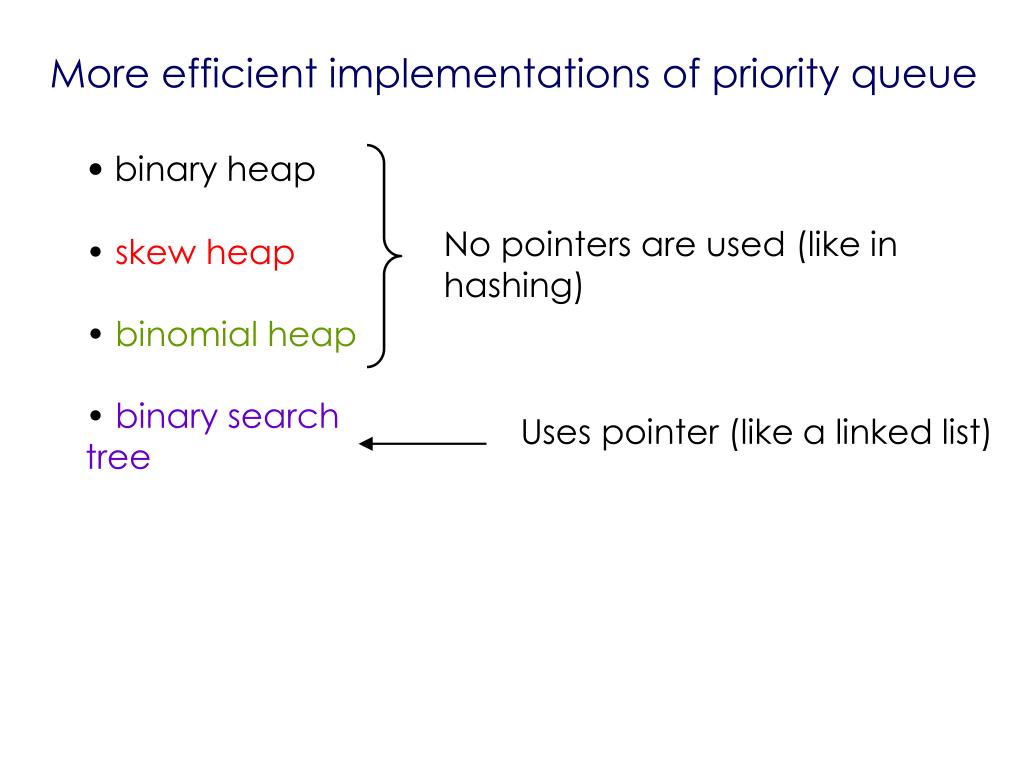
Mapping the elements of a heap into an array is trivial: if a node is stored an index k, then its left child is stored at index 2k + 1 and its right child at index 2k + 2.

It's also used in operating systems for load balancing (server-side load balancing) and interrupt management. Heap sort is commonly accomplished using Heap, a Priority Queue implementation.

The priority queue (also known as the fringe) keeps track of undiscovered routes, with the one with the shortest lower bound on the overall path length receiving the most attention. For example, heaps commonly have a constructor that will build the internal data structure very quickly, without having to call the insert method for each item. A heap typically implements more functionality than is required by a priority queue. Note that the type does not guarantee first-in-first-out semantics for elements of equal priority. Elements with the lowest priority are dequeued first. Each element is enqueued with an associated priority that determines the dequeue order. It is used in Huffman codes to compress data.Ī Search Algorithm*: The A* search algorithm searches for the shortest path between two vertices in a weighted network, prioritizing the most promising paths. Whereas a heap is definitely a priority queue, by no means is it true that a priority queue is a heap. Implements an array-backed, quaternary min-heap. It's used to build Prim's Algorithm, which stores node keys and extracts the smallest key node at each step. While the graph is represented as an adjacency list or matrix, the priority queue may be utilized to extract the minimum efficiently when implementing Dijkstra's algorithm. Priority queue for Dijkstra's Shortest Path Method: Deletion also does not happen at a specific end. Conceptually the heaps can be represented as a complete binary tree. Regardless, they have two basic operations: insert and remove. The queue is a data structure with a front and back where insertion takes place from the back and removal takes place from the frontĪ Priority queue does not have specified ends, so insertion doesn’t happen at a specific end. A heap is a tree data structure that keeps to max or min element at the root. Queue Works on the principle of FIFO(First In First Out) In this type of priority queue, the smallest element gets the highest priority.Priority Queue Works on the principle of the highest priority element will be deleted first Void display_priority_queue(priority_queue pq) įor example, // integers are arranged in ascending order function prototype for display_priority_queue() In C++, the priority_queue class provides various methods to perform different operations on a queue.

Note: By default, STL priority_queue gives the largest element the highest priority. create a priority queue of string type For example, // create a priority queue of integer type Here, type indicates the data type we want to store in the priority queue. Once we import this file, we can create a priority_queue using the following syntax: priority_queue pq In order to create a priority queue in C++, we first need to include the queue header file. In this tutorial, we will learn about the Concept of Min Heap and implementing it using a Priority Queue, in the C++ programming language. To learn more about priority queues, visit our Priority Queue Data Structure. In C++, the STL priority_queue provides the functionality of a priority queue data structure.Ī priority queue is a special type of queue in which each element is associated with a priority value and elements are served based on their priority.


 0 kommentar(er)
0 kommentar(er)
